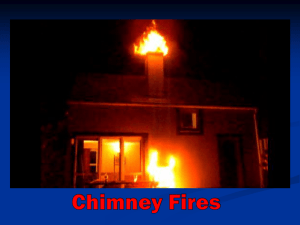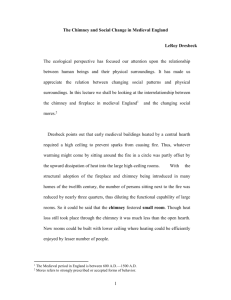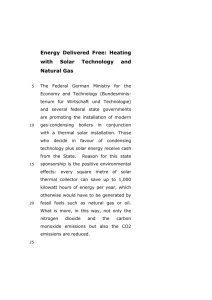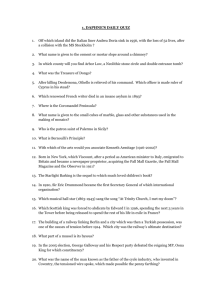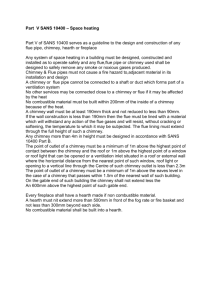Template - International Conference on Arctic Roads 2007
advertisement
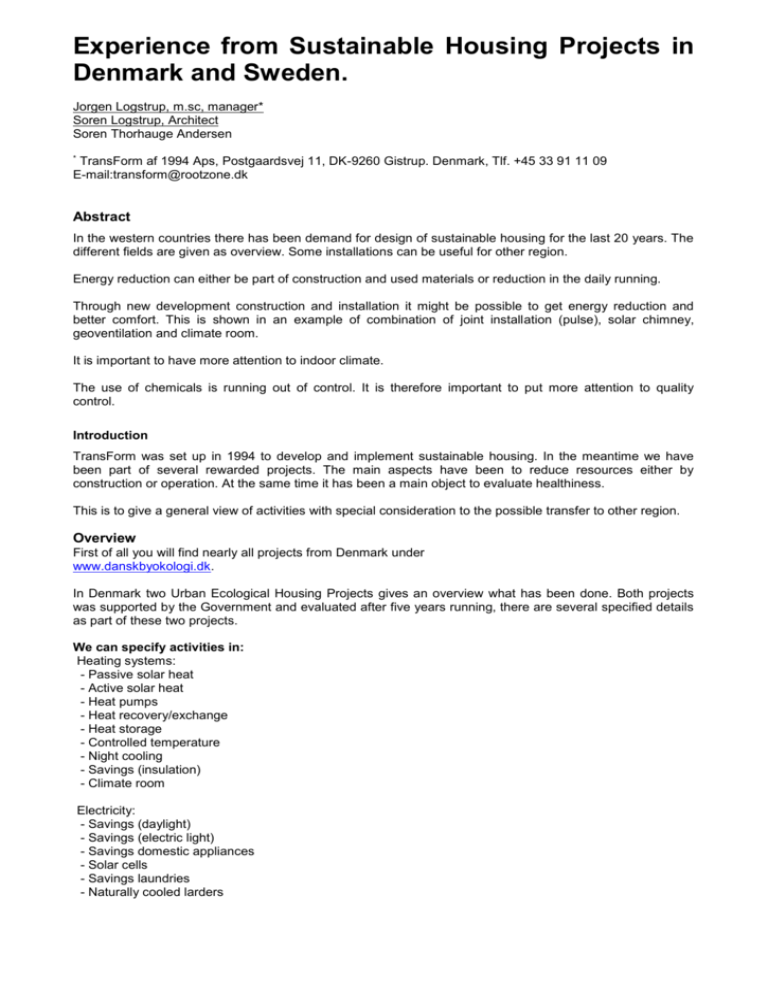
Experience from Sustainable Housing Projects in Denmark and Sweden. Jorgen Logstrup, m.sc, manager* Soren Logstrup, Architect Soren Thorhauge Andersen * TransForm af 1994 Aps, Postgaardsvej 11, DK-9260 Gistrup. Denmark, Tlf. +45 33 91 11 09 E-mail:transform@rootzone.dk Abstract In the western countries there has been demand for design of sustainable housing for the last 20 years. The different fields are given as overview. Some installations can be useful for other region. Energy reduction can either be part of construction and used materials or reduction in the daily running. Through new development construction and installation it might be possible to get energy reduction and better comfort. This is shown in an example of combination of joint installation (pulse), solar chimney, geoventilation and climate room. It is important to have more attention to indoor climate. The use of chemicals is running out of control. It is therefore important to put more attention to quality control. Introduction TransForm was set up in 1994 to develop and implement sustainable housing. In the meantime we have been part of several rewarded projects. The main aspects have been to reduce resources either by construction or operation. At the same time it has been a main object to evaluate healthiness. This is to give a general view of activities with special consideration to the possible transfer to other region. Overview First of all you will find nearly all projects from Denmark under www.danskbyokologi.dk. In Denmark two Urban Ecological Housing Projects gives an overview what has been done. Both projects was supported by the Government and evaluated after five years running, there are several specified details as part of these two projects. We can specify activities in: Heating systems: - Passive solar heat - Active solar heat - Heat pumps - Heat recovery/exchange - Heat storage - Controlled temperature - Night cooling - Savings (insulation) - Climate room Electricity: - Savings (daylight) - Savings (electric light) - Savings domestic appliances - Solar cells - Savings laundries - Naturally cooled larders Water - Saving devices - Use of rain water - Reuse of grey water - Separation and compost toilet Ventilation and Indoor climate - Heat exchange - Transportation of heat/cooling - Air treatment and recirculation/BioVentic - Natural and hybrid ventilation - Controlled ventilation - Solar chimney - Geoventilation Waste - Sorting/recycling - Composting - Handling Building material and construction - Construction materials - Chemicals - Surfaces and their treatment - Cleaning/maintenance - Central installation/Chimney - Minimize outer surface Free Space - Joint installation - Wind bracers Miscellaneous - Wind energy - Biomass energy - Quality control - Monitoring & control of consumptions - Life cycles costs There is a more detailed explanation in “Environmental program for Ecological Institution in Copenhagen Municipality” 2000. The activities can be combined, in a way where you in one construction get several positive effects. Following we will take up some showcases Cases: 1.1 Pulse - Joint installations. In the Western world we have separated every special infrastructure activity. We install and build roads, railroads, electricity, water, sewage, heating etc. by different groups and separate from each other. By every installation or maintenance we are digging, using costly machine energy instead of cooperate. The physical infrastructure is not coordinated by planning. In India all joint installation has to go in the same corridor from high voltage installation, road, and water to sewage. Pulse is a design, where all installations are put in the same flexible open pipe construction or in a common installation cave. The pipe is covered with concrete flagstone on top. By any damage it easy to take of the flagstone and repair. At the same time on top of the flagstone you can have footpath or road. Pulse may also be used in geoventilation for air intake. 1.2 Natural ventilation with solar- and wind chimney Following up to have all installation in the same construction, we take in installations horizontal from outside, and transfer them to a vertical chimney in the centre of the house or flat. If it is a storied building, this gives the possibility to diversify the flats after individual wish. It also reduces your installation cost, because it minimizes construction and material. If the chimney is constructed in heavy materials like concrete or bricks it will function as heat resistant. In Ecohouse 99 the south façade is glass and the sun is heating up the chimney. This is a way where you can make use of passive solar heating. The chimney can also be used as solar chimney. By painting the top in dark colour, the sun will heat it up and accelerate ventilation. By having an aerofon on top of the chimney the wind will accelerate the ventilation. In this way we make natural ventilation more effective. (The Blue House, Østratornskolan, Pakhuset). 1.3 Geoventilation The temperature in the underground is a balance of variation in the outside temperature. In summertime the ground temperature will be lover than outside. In wintertime the ground temperature will be higher. Fig.1.Geoventilation with wind chimney, Østratornskolan, Lund, Sweden If the air intake is connected and transferred to ground temperature, we will raise the intake temperature in wintertime even if we are under 0C. It might be from -10C up to +5C. In summertime it is opposite, we reduce the temperature from may be +30C dawn to +15C. This system is used to reduce the heating and cooling cost in ventilation. In Sweden it has been used for natural ventilation construction in several schools (Østratornskolan, Pakhuset). In this case the main cost reduction is coming from heating up the intake air. Under higher temperature condition the main result is coming from cooling. The system can also be used for naturally cooled larders (The Blue House, Inspectoren, and Fælleshuset in Hedebygadekareen). The air intake is placed outside the building in a concrete chimney about 1,5m high if possible in a green area. The chimney is transferred to 10-30m long concrete pipe or corridor placed 1-1,5m below surface. The surface has to be green. A vegetative surface will always be under 28C in summertime and isolate in wintertime. Fig.2. Outline of joint installation with Geoventilation and solar chimney 1.4 Climate room The situation by high temperature differences is that isolation has to be very efficient; alternative the heating cost will be high. Another problem is to secure against cool bridged and draught from door and windows. The idea behind climate room is to cut the temperature differences in two steps. It has been used in some constructions as well in the old days as in new buildings in form of two doors entrance. However the climate room can be constructed as a cover around the building as rooms where you accept it cooler as in the living rooms or façade/windows where there is a free room between the inner wall/glass and the outer wall/glass. The intake of air and the outgoing air is going through the climate room, either mixed in the room or through heat exchange. Construction with Installation-, solar- and wind chimney, geo-ventilation and climate room has reduced the heating cost in Swedish schools with 50-60% of the average heating cost (Østratornskolan). The climate room in concept developed together with NASA can also be used for grey- and rainwater treatment and storing. It may also be used for air treatment (Inspectoren) Fig.3. Climate room with air and grey water treatment, Inspectoren, Kalmar, Sweden 1.5 Air Treatment In many regions the indoor climate is a costly problem. Under cold condition the main running cost is heating up all air intakes. Under hot weather the cost are cooling dawn the air intake, this can be done with Geoventilation, but it might also be supplied by air treatment and recirculation. Air treatment with a light soil filter with vegetation, so called root zone has supported indoor climate. Installation can either be built-in or in pots. Standard pots are developed with cleaning/filtering up to 75m3/h. Energy cost are 38W/h. The system is binding particle, chemical, and germs in the filter. Organic material is decomposed by microbiological activity. The temperature reduction is about 3C. 1.6. Chemicals. Chemicals in building construction as stopping, glue, prime, joint pulp, foam, draught excluder, smoothing pulp etc. are today used without criticism. In Denmark and Sweden we use in average 14-15 kg chemicals/m2 constructed area. By setting up alternatives to chemicals and to make quality control under construction it is possible to reduce use of chemicals to less than 1 kg/m2. References Projects: - Økobyen Toarp, Malmø with arc. Krister Wiberg. - The Blue House, Aalborg with arc. Friis & Moltke. - Ecohouse 99, Aarhus and Ikast with arc. Vandkunsten - Lessor A/S, Allerød with arc. Peter van Hauen - Ecological theatre workshop, Jytte Abildstrøm with Flemming Abrahamson - Flat of the future, Inspectoren, Kalmar with arc. Søren Løgstrup - Østratornskolan, Lund with White Arkitekter AB - Pakhuset, Odder Kulturhus with arc. Niels Engelund - Hedebygadekareen, Fælleshus and Flora with arc. Niels Peter Flint, Domus and C.F.Møller Literature: - Catalogue on Ecological Systems, SBS Byfornyelse 1997 Miljøprogram for økologiske Daginstitutioner I Københavns Kommune, 2000


